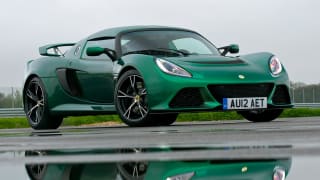
Lotus Exige 2015 review
Peter Barnwell road tests and reviews the 2015 Lotus Exige S auto.
Browse over 9,000 car reviews
All the numbers tell me I should be loving the new Porsche Boxster.
It’s a quicker sprinter than before, faster at the top end, has more power, uses less fuel and also has some snappy visual and cabin tweaking.
How about those figures: 220kW and 380Nm, with a 4.9-second sprint to 100km/h and fuel use as low as 7L/100km? The multi-mode driving dynamics come down from the 911, including the sensational “push-to-pass” feature that primes the gearbox and engine for a big instant hit of overtaking power or for injecting more smiles into a twisty road.
There are also bigger brakes, wheels and tyres on the car that’s officially known as the Boxster 718. It’s already a runaway success with keen drivers around the world, who are talking more about the improved performance than Porsche’s move — sparked by fuel economy and emission requirements — to install turbocharged four-cylinder engines in place of the previous signature flat-sixes.
So I’m looking forward to my time for The Tick in a basic 718 convertible with the 2.0-litre turbo four.
Then I get in, hit the starter button and the 2017 Boxster time-warps me back to my first car. That would be fine if my first car was a Porsche. But no. It was a 1959 Volkswagen Beetle, and the exhaust sound in the new four-cylinder Boxster is exactly the same — to my ears, anyway — as that ancient Bug. Chugga-chugga.
Some people say the first four-cylinder Porsche since the 1980s, when the German sports car specialist had the frontengined 924-968 collection, sounds like a Subaru WRX. But not to me. And even the Boxster’s turbo whistle reminds me of the noise from the cooling fan in that ancient Beetle.
It produces huge torque virtually from walking speed.
But let’s be professional, disregard the sound and take a look at a car that is significantly updated. Porsche claims 80 per cent of the chassis and body parts are new. The body has more creases and new headlamps, the folding roof still takes 10 seconds to operate at up to 50km/h, and there is a reversing camera in the latest multimedia package.
The Boxster has never been cheap and this one starts at $112,800. The example tested for The Tick comes in at $148,380 before on-roads thanks to the seven-speed PDK doubleclutch auto, 20-inch alloys, active suspension, GT wheel and Porsche crests embossed onto the seats. But this is typical for a Porsche purchase, which is never about the bottom line, even though it’s moved up by about $9000 this year.
This Boxster is as sharp as I remember, perhaps even more crisp in the way it responds to the steering, and the turbo four is a blast. It produces huge torque virtually from walking speed and there is a real surge of top-end power from the relatively modest 2.0-litre displacement (the beefier 2.5 variant puts out
257kW/420Nm).
The mid-range surge is the best thing, as in all the latest turbos, and the seven-speed auto means there is an ideal ratio for any situation. It’s fun to tweak down with the paddles for tight turns, then shift early and often to keep the car moving along.
The brakes are great and revised steering is even more feel-good than I remember, communicating everything from the front wheels.
The roof is just as before and the cabin is much the same, although I like the reversing camera and the push-pass button lurking on the good looking wheel. The ride is good, even on the 20-inch wheels, and the noise levels are fine for the car and class. It can boom on some surfaces but there’s nothing truly nasty.
A Porsche is more about the heart than the head.
There is no official safety rating for the Boxster but it has six airbags and electronic safety kit. Some people will complain there is no spare, not even a space-saver, but once again that’s typical for Porsche. So we come back to the sound.
To get some perspective I call a couple of mates with sports cars, one who has an Aston Martin and another with a Lamborghini, to get their take. Both are emphatic that the sound is a huge ingredient in any successful sports car and they’re surprised that the fourpot Boxster has lost the scream that’s always been a sixpack Porsche signature.
I take the matter up with Porsche Cars Australia boss Sam Curtis: “Porsche buyers don’t care. Sales of the Boxster have never been better.” So there.
The head says a definite yes, and so do all the sensory organs that soak up the delights provided by the big numbers from the new car.
The downsized engine makes sense at every level but one — the sound — and that should be more than good enough for anything arriving from one of the world’s great carmakers.
But, for me, it’s not enough. In the end, a Porsche is more about the heart than the head and that means I can’t give The Tick to the Boxster. Maybe next time, once Porsche has done some tweaking of the soundtrack.
| Vehicle | Specs | Price* | |
|---|---|---|---|
| (base) | 2.7L, PULP, 7 SP AUTO | $46,530 – 54,120 | 2016 Porsche Boxster 2016 (base) Pricing and Specs |
| Black Edition | 2.7L, PULP, 7 SP AUTO | $49,720 – 57,090 | 2016 Porsche Boxster 2016 Black Edition Pricing and Specs |
| S | 3.4L, PULP, 7 SP AUTO | $58,410 – 67,100 | 2016 Porsche Boxster 2016 S Pricing and Specs |
| GTS | 3.4L, PULP, 6 SP MAN | $63,580 – 73,040 | 2016 Porsche Boxster 2016 GTS Pricing and Specs |
$44,330
Lowest price, based on third party pricing data